Overview
Many people started out macro photography with close up add-on lenses, some are cheap and some are not so cheap. One set of well known and widely used add-on lenses are Raynox DC-150 and DC-250. These close up add-on lenses are very convenient to use, simply screw/clip it onto a (usually) telephoto (zoom) lens. The results can be stunning as evidenced by many beautiful images shot with them.

There is another use for these Raynox close up lenses: they can be used as tube lens for infinite microscope objective!
We know that an infinity corrected objective needs another optical piece, called tube lens, to project an image onto a surface, in our case image senor of our DSLR camera. Raynox close up lenses can do just that, projecting light rays onto camera sensor when positioned correctly and it has been proven the results are excellent, even for high end expensive APO objectives. Cool, right!
So theoretically the purpose of tube lens is to focus light beams coming out of microscope objectives onto our DSLR sensor, therefore, it is necessary to position the Raynox (as tube lens) at right position so that its focal plane coincides with the sensor plane. To do this, the Raynox must be placed at its focal length distance from the sensor. For Raynox DCR-150, the focal length is approximately 208.33mm and it should be placed at 208.33mm away from the sensor. Similarly, for Raynox 250, the focal length is 125mm, therefore it must be placed at 125mm away from the sensor plane.
Determining The Right Extension Length
It is rather difficult to place the Raynox add-on lenses EXACTLY by physically measuring the distance because of lack of precise parts available. However, it is rather easy to configure it optically — mounting it onto the camera and try to focus it to infinity. So the best way is to pick something very far away with a lot of texture, adjust the placement of Raynox lens until you get a sharp focus. Here is an example.
 This is shot with Raynox DCR-150 focused onto a building pretty far away. Note, the actual image quality is very hazy, this image was dehazed in Adobe Lightroom. You can see a lot of details — meaning the DCR-150 is at right place from the sensor.
This is shot with Raynox DCR-150 focused onto a building pretty far away. Note, the actual image quality is very hazy, this image was dehazed in Adobe Lightroom. You can see a lot of details — meaning the DCR-150 is at right place from the sensor.
Because Raynox add-on lenses are not designed for photographing alone, most of the time the image will be hazy, so it is better to use the digital zoom feature of your camera to help determining focus. It is also better to do this at night and aim at lights far away.
Using Raynox As Tube Lens (Normal Orientation)
Both Raynox 150 and Raynox 250 have 49 mm female filter thread in front of it and 43 mm male thread at the end. In this blog, I am trying to find a generic solution so that this approach can be used for other type of cameras. I have mentioned that I personally like to use standard “dumb” extension tubes. These are without any electrical contacts for the type of camera we have and convert the extension tube to end with M42. So here is one way of assembling it together with a M42 male thread at the end.
 Mounting an objective on to a Canon EOS camera, for Nikon camera, standard dumb extension tube for Nikon camera can be used instead of the one for Canon
Mounting an objective on to a Canon EOS camera, for Nikon camera, standard dumb extension tube for Nikon camera can be used instead of the one for Canon
The above picture shows an example of setting it up for Canon EOS camera, for other cameras, simply use standard dumb extension tube for the camera. Since I have shown you how to put an infinite microscope objective on a standard extension tube (without electrical contacts), now it is important to determine how long the extension tube should be for different cameras.
Raynox DCR-150
The Raynox 150 has a focal length of 208.33 mm. What his means is that we need to place it EXACTLY 208.33 mm away from the sensor. For Canon EOS camera with EF mount or EF-S mount, the registered distance is 44 mm (distance from the mount to the sensor plane), this means the total extension tube should be 208.33 – 44 = 164.33 mm in length. For Nikon camera, the registered distance is 46.5 mm, the extension tube length should be 208.33 – 46.5 = 161.83 mm. The same goes with other type of camera mounts.
 Extension Tube Length for DCR-150
Extension Tube Length for DCR-150
Raynox DCR-250
Even though Raynox DCR-250 has shorter focal length than most infinite objectives requires, it is often used as tube lens but with reduced magnification than designed for the infinite objective. The actual magnification is calculated as following:
Real M = Designed M * 125/required tube lens focal length in mm
For example, if a 10X objective requires 180mm focal length for tube lens (most Olympus RMS objectives), if it is mounted on to Raynox DCR-250 as tube lens, its real magnification is 10*125/180 = 6.94x
The required tube lens focal length varies from different microscope objective manufacturers. Typically microscope objectives from same manufacturer usually require the same tube lens focal length. If you purchase a generic microscope objective, it is best practices to ask your vendor where you purchase it from. Here are some typical tube lens focal length from different manufacturer:
- Olympus — 180 mm
- Nikon — 200 mm, note, some Nikon have 210 mm marked on them, but the actual tube lens focal length requirement is 200 mm because Nikon, for some reason, measures from the tip of the objective
- Mitutoyo — 200 mm
Same principle as with Raynox DCR-150, it must be placed at EXACTLY its focal length away from camera sensor which is 125 mm away. Since different camera has different flange distance, so extension tube length is dependent on camera type. Here is a table:

Extension Tube Length for DCR-250
A list for the flange distance for nearly every camera model can be found on wikipedia: https://en.wikipedia.org/wiki/Flange_focal_distance
Obviously, it is very hard to find an extension tube with such exact length, therefore, it is important to have a variable length extension tube. There is ONE important components in above picture: the MJKZZ VLE.

This component allows you to adjust total length of extension so that the Raynox is placed at right position to be used as tube lens — by changing how far the inner ring extends. This components allows you to vary total length between 20 mm to 30 mm, so there should be enough room for different camera mount and Raynox. Of course, it is highly recommended to keep this variable length as short as possible.
One thing about standard extension tubes without electrical contacts is that they seem all come with three segments of 7 mm, 14 mm and 28 mm long and a 10 mm long female lens mount segment and 5-7 mm male lens mount segment. These segments can be screwed together to form longer length and this is very convenient.
Some Examples With Raynox 150
With long focal length of 208.33mm, the DCR-150 needs long extension length for most camera mounts. Here are some example:
Canon EF or EF-S mount — you need three sets of extension tubes and here are details of configuration. With the following configuration, the variable extension needs to extend out just a little bit.
- three 28-mm segments,
- three 14-mm segments,
- one MJKZZ-VLE,
- one EOS-M42,
- one male lens mount and
- one female lens mount.
Canon EF-M mount — you need three sets of extension tubes and here are details of configuration. With the following configuration, the variable extension needs to extend out about 8 mm.
- three 28-mm segments,
- three 14-mm segments,
- three 7-mm segments,
- one MJKZZ-VLE,
- one EOS-M42,
- one male lens mount and
- one female lens mount.
Nikon F mount — you need three sets of extension tubes and here are details of configuration. With the following configuration, the variable extension needs to extend out about 7 mm.
- three 28-mm segments,
- two 14-mm setments,
- one 7-mm segments,
- one MJKZZ-VLE,
- one Nikon-M42,
- one male lens mount and
- one female lens mount.
Some Examples With Raynox 250
With focal length of 125 mm, the DCR-250 needs to be placed at 125 mm away from camera sensor (not from lens mount). Here are some example:
Canon EF or EF-S mount — you need one set of extension tubes and here are details of configuration. With the following configuration, the variable extension needs to extend out about 4 mm.
- one 28-mm segments,
- one 14-mm segments,
- one MJKZZ-VLE,
- one EOS-M42,
- one male lens mount and
- one female lens mount.
Canon EF-M mount — you need two sets of extension tubes and here are details of configuration. With the following configuration, the variable extension needs to extend out about 2 mm.
- two 28-mm segments,
- one 14-mm segments,
- one MJKZZ-VLE,
- one EOS-M42,
- one male lens mount and
- one female lens mount.
Nikon F mount — you need one set of extension tubes and here are details of configuration. With the following configuration, the variable extension needs to extend out about 1 mm.
- one 28-mm segments,
- one 14-mm setments,
- one MJKZZ-VLE,
- one Nikon-M42,
- one male lens mount and
- one female lens mount.
Summary
To summarize, the key point of using Raynox (or any other dioptor lens) as tube lens is to place it at right distance from camera sensor (not lens mount) using either bellow, extension tubes with variable extension, or any other means. And to determine the right distance is to focus the setup to infinity and obtain a sharp image. Different camera has different flange distance (distance from the sensor to lens mount), so it is not possible to have one set of extension for all cameras, variable extension is highly recommended.



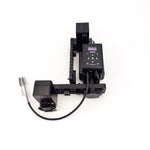
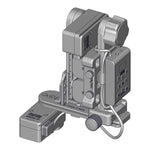
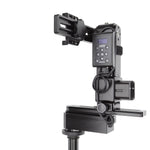
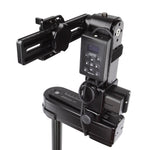
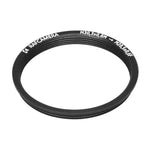
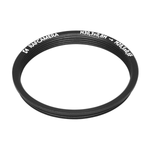

 This is shot with Raynox DCR-150 focused onto a building pretty far away. Note, the actual image quality is very hazy, this image was dehazed in Adobe Lightroom. You can see a lot of details — meaning the DCR-150 is at right place from the sensor.
This is shot with Raynox DCR-150 focused onto a building pretty far away. Note, the actual image quality is very hazy, this image was dehazed in Adobe Lightroom. You can see a lot of details — meaning the DCR-150 is at right place from the sensor. Mounting an objective on to a Canon EOS camera, for Nikon camera, standard dumb extension tube for Nikon camera can be used instead of the one for Canon
Mounting an objective on to a Canon EOS camera, for Nikon camera, standard dumb extension tube for Nikon camera can be used instead of the one for Canon


